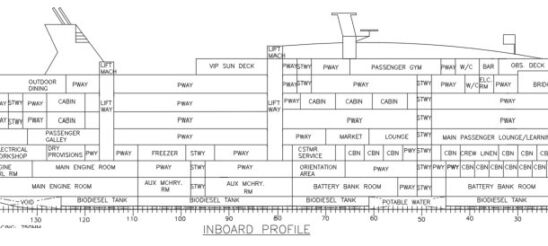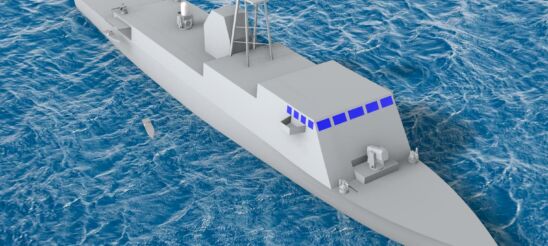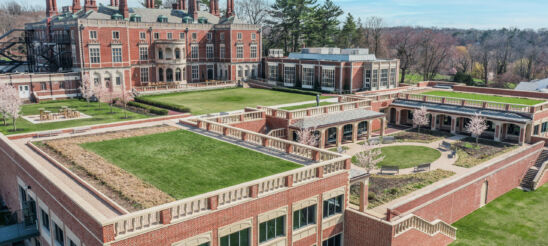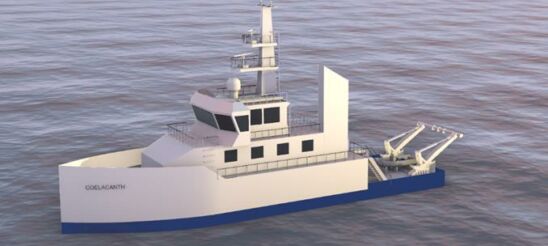Webb Institute Named a 2023 Best College by College Raptor
Webb Institute has been selected as a 2023 Best College in the U.S. by College Raptor, a leading college planning platform that helps families discover college matches driven by AI algorithms to find the best colleges at the best price.
Webb Institute was ranked:
#20 in Top 25 Best Small Colleges
#23 in Top 25 Best Mid-East Colleges
This selection recognizes Webb Institute as a leading institution in the country based on a combination of factors including the school’s graduation rates, campus diversity, endowment per student, and other key metrics as reported via the National Center for Education Statistics (NCES) for the most recently available enrollment year.
“Since 2015, we’ve carefully assembled our lists each year to highlight the best schools in different categories to help families get started in the discovery process,” said Bill Staib, College Raptor’s CEO. “Webb has shown dedication to academic excellence. We are proud to highlight them.”
College Raptor’s full methodology is outlined here.
About College Raptor, Inc.
College Raptor® is the most evolved, accurate, and comprehensive college search site with tools to empower students, parents, counselors, and colleges with college planning. College Raptor is the only college search platform that enables students and families to discover quality, affordable college options based on personalized estimates of financial aid, scholarships, academic match, and acceptance odds at every 4-year college in the country. More than 25 million students and families have used College Raptor to find cost-effective, academically appropriate college options that prepare them for future careers. For more information, visit CollegeRaptor.com.
SD1 Projects: M/V Steve Irwin
Designers: Jonathan Allen, Eric Heilshorn, Spencer Margosian, Kasey Kennedy
Vessel Type: Expedition Cruise Ship
Vessel Mission:
The Steve Irwin is a vessel capable of bringing you to the edges of civilization to experience adventures the untouched world has to offer. From snorkeling in the Galapagos to polar plunges in the Arctic, guests simultaneously experience luxury and explore the unknown while accompanied by revered experts in the fields of photography and exploration.
Characteristics and Features:
Passenger (double berths) [150 total]
• 9 Premium Cabins
• 10 Plus Cabins
• 52 Standard Cabins
Crew Accommodations [110 total]
• 24 Single Berths (including Chief Engineer and Master cabins)
• 18 additional single berths capable of conversion to passenger cabins
• 34 Double Berths
Length (Overall): 120 m
Beam (Overall): 20 m
Draft: 5 m
Displacements
• Lightship: 6,200 MT
• Arrival: 8,884 MT
• Departure: 10,714 MT
Design Speed: 15 kts
Cruising Speed: 13 kts•Length (Overall): 120 m
View Presentation
Visit our Junior Class Small Vessel Design Project page to view all of this year’s projects.
About Junior Class Small Vessel Design Project (SD1):
As a part of Professor Bradley D.M. Golden’s ’99 Ship Design 1 (SD1) class, the juniors spent the first two-and-a-half months of the spring semester preparing their first complete concept designs.
Using the knowledge they’ve gained in their nearly three years studying at Webb and the experiences from their winter work periods to date, this was the students’ first opportunity to apply the naval architecture and marine engineering principles they’ve studied including stability, ship’s structures, main machinery systems, auxiliary systems, resistance and propulsion, and electrical engineering.
Working in small groups of three and four, the students selected one of the vessel types and took their first couple of spins around the design spiral to prepare vessel concept designs. To help make the project as realistic as possible, members of industry familiar with each of the vessel types helped prepare the statements of design requirements that each of the designs had to meet. To challenge the students even further, one or two “curveballs” were thrown into each design statement to make the students think long and hard about how they would achieve their objectives.
At the end of the spring semester, the students presented their final designs to their fellow students, faculty, and members of industry who served as part of an evaluation team. After three years at Webb, the Junior class can now say with confidence that they’re familiar with the design process and are well on their way to joining the fields of naval architecture and marine engineering.
SD1 Projects: USS Minesota
Designers: Kyle Murphy, Gabriel Allen, Alex Resio, Jacob Dillistin
Vessel Type: Minesweeping Countermeasure Mothership
Vessel Mission:
Provide a new method for handling mine countermeasure operations with the use of mine countermeasure units-remote/autonomous (MCU-RAS). The use of MCU-RAS in mine countermeasures allows the coverage of larger minefield areas as compared to traditional minesweepers while minimizing the risk to personnel and naval assets.
Characteristics and Features:
• Overall Length: 108.75 m
• Beam: 14.5 m
• Depth: 9 m
• Max Speed: 32 kts
• Cruising Speed: 16 kts
• Installed Power: 43.4 MW
• Range: 4000 nm
• Compliment: 76 persons
• Endurance: 30 days
• Service Life: 40 years
• Full Load Displacement: 3540 tonne
• Platform for deployment, recovery, and maintenance for a fleet of 30 MCU-RAS
• Launches all MCU-RAS in less than 3 hours, recovers in less than 12 hours
• Flight deck for helicopter support
View Presentation
Visit our Junior Class Small Vessel Design Project page to view all of this year’s projects.
About Junior Class Small Vessel Design Project (SD1):
As a part of Professor Bradley D.M. Golden’s ’99 Ship Design 1 (SD1) class, the juniors spent the first two-and-a-half months of the spring semester preparing their first complete concept designs.
Using the knowledge they’ve gained in their nearly three years studying at Webb and the experiences from their winter work periods to date, this was the students’ first opportunity to apply the naval architecture and marine engineering principles they’ve studied including stability, ship’s structures, main machinery systems, auxiliary systems, resistance and propulsion, and electrical engineering.
Working in small groups of three and four, the students selected one of the vessel types and took their first couple of spins around the design spiral to prepare vessel concept designs. To help make the project as realistic as possible, members of industry familiar with each of the vessel types helped prepare the statements of design requirements that each of the designs had to meet. To challenge the students even further, one or two “curveballs” were thrown into each design statement to make the students think long and hard about how they would achieve their objectives.
At the end of the spring semester, the students presented their final designs to their fellow students, faculty, and members of industry who served as part of an evaluation team. After three years at Webb, the Junior class can now say with confidence that they’re familiar with the design process and are well on their way to joining the fields of naval architecture and marine engineering.
Webb Institute Receives Project Excellence Award by Preservation Long Island
Preservation Long Island works with communities throughout the region to protect and celebrate historic places, encouraging excellence in stewardship and advocacy. Their biennial Preservation Awards recognize individuals, organizations, and projects that demonstrate extraordinary achievement in fields related to historic preservation on Long Island.
“This year’s awardees demonstrate not only excellence in historically sensitive design and rehabilitation, they also represent successful historic preservation efforts in a wide range of 2 areas that include public education and access, community-driven leadership, and a commitment to leveraging the municipal process to achieve local preservation objectives,” said Alexandra Wolfe, Preservation Long Island Executive Director.
Project Excellence
- Webb Institute and Bentel & Bentel Architects for historically sensitive design of the Couch Academic Center, a new facility for teaching, learning, and collaboration in Glen Cove.
- Paul and Catherine Herkovic, historic homeowners, for outstanding stewardship and rehabilitation of the Stanley H. Lowndes House in Northport.
Organizational Excellence
- Southampton African American Museum (SAAM) for excellence in education and advocacy for the preservation of Black heritage sites in Southampton Village.
- Ma’s House & BIPOC Art Studio for creative community-driven leadership in preserving Ma’s House as a shared art space, studio, and library at the Shinnecock Indian Reservation.
- Van Wyck-Lefferts Tide Mill Sanctuary & Huntington Historical Society for their innovative approach to public access and stewardship at the Van WyckLefferts Tide Mill.
- Village of East Hills for leadership in new approaches to local preservation and for achieving a meaningful mitigation of adverse impacts on John Mackay III’s Happy House via environmental review.
“In recognition of exceptional achievement in the historically sensitive design of the Couch Academic Center, a new facility for teaching, learning, and collaboration in Glen Cove. The brick façade and green roof blend seamlessly with historic Stevenson Taylor Hall and other campus structures overlooking the Long Island Sound. The Couch Academic Center features new collaborative learning spaces, studios, lecture halls, computer/makers labs, faculty offices, and a student lounge. Construction began on July 23rd, 2018. The project took approximately 14 months to complete with classes transitioning to the new academic center during the 2020 spring semester.”
Preservation Long Island 2022 Award Article
Each of the six awardees will be recognized in award presentations and related programming taking place from June and through September. “We are excited to be able to return to showcasing our awardees at in-person events throughout Long Island,” said Sarah Kautz, Preservation Director at Preservation Long Island.
Webb Institute and Bentel & Bentel Architects received their award at Preservation Long Island’s Annual Benefit Party on Friday, June 24th.
About Preservation Long Island
Preservation Long Island is a not-for-profit organization that works with Long Islanders to raise awareness, appreciation, and support for the protection of our shared past through advocacy, education, and the stewardship of historic sites and collections.
Preservation Long Island’s preservation advocacy services support the work of our local partners in communities across the region. We offer consultation and strategic guidance for Long Islanders seeking help with local preservation projects, including historic resource surveys, local landmark designation, National Register listing, and restoration or adaptive reuse of historic buildings. Our Local Landmark Law Look-Up Tool provides Long Islanders with an easy way to explore landmark laws in our region.
http://preservationlongisland.org
Preservation Long Island also maintains and interprets historic sites and collections that embody various aspects of Long Island’s history including:
Joseph Lloyd Manor, Lloyd Harbor
Custom House, Sag Harbor
Sherwood-Jayne Farm, Setauket
Old Methodist Church and Exhibition Gallery, Cold Spring Harbor
SD1 Projects: R/V Coelacanth
Designers: Victoria Kim, Alexander Lytle, Lorenzo Pensabene, Natalie Webb
Vessel Type: Oceanographic Research Vessel
Vessel Mission:
The research vessel is intended to meet the demand for small and efficiently crewed research vessels that are suitable for coastal and near-shore research projects. Its purpose is to provide a platform to support a wide range of general marine and ocean sciences that is cost efficient and environmentally friendly.
Features:
• Hybrid battery/deisel electric.
• A-frame crane and J-frame crane for in water instruments and remotely operated equipment.
• Capability to carry, deploy, and maintain:
• One 15-foot high-speed RHIB.
• Six medium-sized AUVs.
• Four small ASVs.
• Over 400 square feet of lab space.
• Accomodates 12 scientists and 5 crew.
• Uncontaminated seawater system.
• Flying bride observation station with two big eye binocular mounts.
• Two oceanographic winches.
• Axe bow
• Dual 660 kW azimuthing L-drives
View Presentation
Visit our Junior Class Small Vessel Design Project page to view all of this year’s projects.
About Junior Class Small Vessel Design Project (SD1):
As a part of Professor Bradley D.M. Golden’s ’99 Ship Design 1 (SD1) class, the juniors spent the first two-and-a-half months of the spring semester preparing their first complete concept designs.
Using the knowledge they’ve gained in their nearly three years studying at Webb and the experiences from their winter work periods to date, this was the students’ first opportunity to apply the naval architecture and marine engineering principles they’ve studied including stability, ship’s structures, main machinery systems, auxiliary systems, resistance and propulsion, and electrical engineering.
Working in small groups of three and four, the students selected one of the vessel types and took their first couple of spins around the design spiral to prepare vessel concept designs. To help make the project as realistic as possible, members of industry familiar with each of the vessel types helped prepare the statements of design requirements that each of the designs had to meet. To challenge the students even further, one or two “curveballs” were thrown into each design statement to make the students think long and hard about how they would achieve their objectives.
At the end of the spring semester, the students presented their final designs to their fellow students, faculty, and members of industry who served as part of an evaluation team. After three years at Webb, the Junior class can now say with confidence that they’re familiar with the design process and are well on their way to joining the fields of naval architecture and marine engineering.







